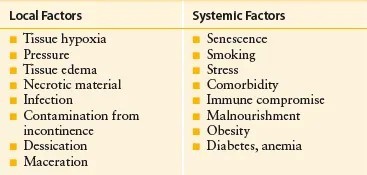What age-related factors may factor into this client's wound healing? Select all that apply.
Insulin resistance
Decreased epidermal turnover
Pigmentation changes
T-cell function decrease
Polypharmacy
Decreased subcutaneous padding
Correct Answer : B,D,F
As people age, the turnover of skin cells decreases, resulting in slower wound healing. This can prolong the healing process and increase the risk of complications.
The immune system's function, including T-cell function, tends to decline with age.
T-cells play a crucial role in the immune response and wound healing. Decreased T-cell function can impair the body's ability to fight infection and promote efficient healing.
With aging, there is a natural loss of subcutaneous fat, which can affect wound healing. Subcutaneous fat provides padding and protection to the underlying tissues, and its reduction can increase the risk of tissue damage and delays in healing.
Insulin resistance, pigmentation changes, and polypharmacy are not directly age-related factors that impact wound healing. Insulin resistance is a condition related to impaired glucose metabolism and can affect wound healing in individuals with diabetes or other metabolic disorders, but it is not necessarily an age-related factor. Pigmentation changes and polypharmacy (the use of multiple medications) may be associated with aging but do not directly affect the physiological processes involved in wound healing.

Nursing Test Bank
Naxlex Comprehensive Predictor Exams
Related Questions
Correct Answer is ["1.3"]
Explanation
1. Convert the infant's weight from pounds to kilograms. We can use the conversion factor 1 kg
= 2.2 lb. So, 22 lb x (1 kg / 2.2 lb) = 10 kg.
2. Calculate the total daily dose of amoxicillin for the infant. We can use the formula D = d x W, where D is the total daily dose, d is the dose per kg per day, and W is the weight in kg. So, D = 20 mg x 10 kg = 200 mg.
3. Calculate the single dose of amoxicillin for the infant. We can divide the total daily dose by the number of doses per day. Since the prescription is for every 8 hours, there are 3 doses per day. So, 200 mg / 3 = 66.67 mg.
4. Calculate the volume of amoxicillin suspension for the single dose. We can use the ratio of the concentration of the suspension, which is 250 mg per 5 mL. So, 66.67 mg x (5 mL / 250 mg) =
1.33 mL.
5. Round the volume to the nearest tenth= 1.3 mL
Correct Answer is ["A","B","C","D","E"]
Explanation
It is important to assess the child's vital signs, including oxygen saturation (SaO2), to ensure their stability and identify any signs of respiratory distress or other abnormalities that may impact medication administration.
Prior to administering any medication, it is crucial to verify if the child has any known allergies to medications. This information is essential for ensuring the safety of the child and preventing any potential allergic reactions.
Before administering pain medication, the nurse must verify that the prescribed dosage is appropriate for the child's age, weight, and condition. Ensuring the correct dosage helps prevent medication errors and potential adverse effects.
It is important to use a validated pain assessment tool that is appropriate for the child's age and cognitive abilities. This allows for a comprehensive and accurate assessment of the child's pain level, helping guide appropriate pain management interventions.
Considering the child has cognitive and speech delays, the input from the parent regarding the child's pain is valuable. The nurse should assess and consider the parent's report of the child's pain in conjunction with other assessment findings to ensure effective pain management.
Subjective pain assessment is mentioned as a finding but may not require immediate action, as it needs to be combined with other assessment data for a comprehensive evaluation.
Whether you are a student looking to ace your exams or a practicing nurse seeking to enhance your expertise , our nursing education contents will empower you with the confidence and competence to make a difference in the lives of patients and become a respected leader in the healthcare field.
Visit Naxlex, invest in your future and unlock endless possibilities with our unparalleled nursing education contents today
Report Wrong Answer on the Current Question
Do you disagree with the answer? If yes, what is your expected answer? Explain.
Kindly be descriptive with the issue you are facing.
